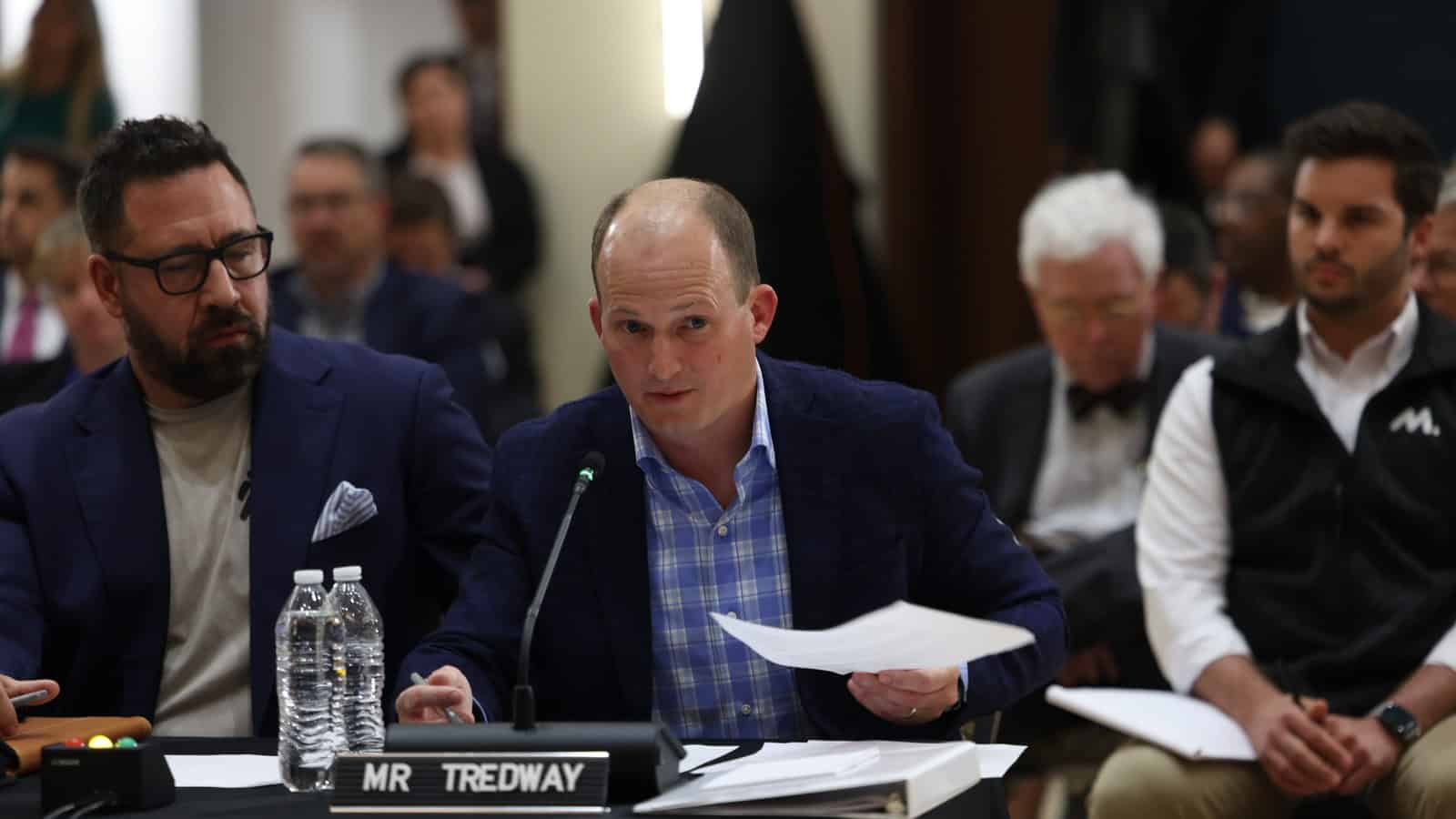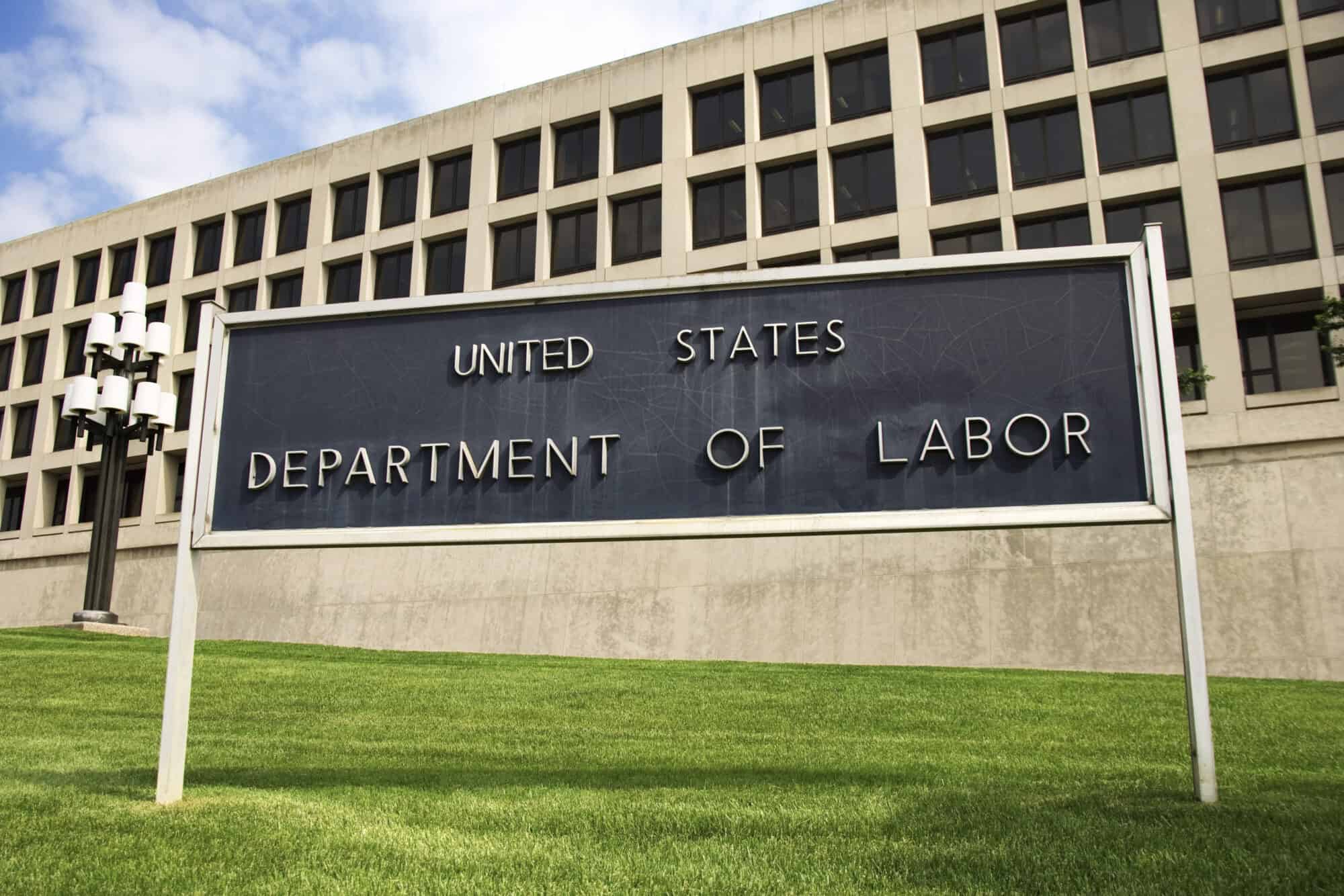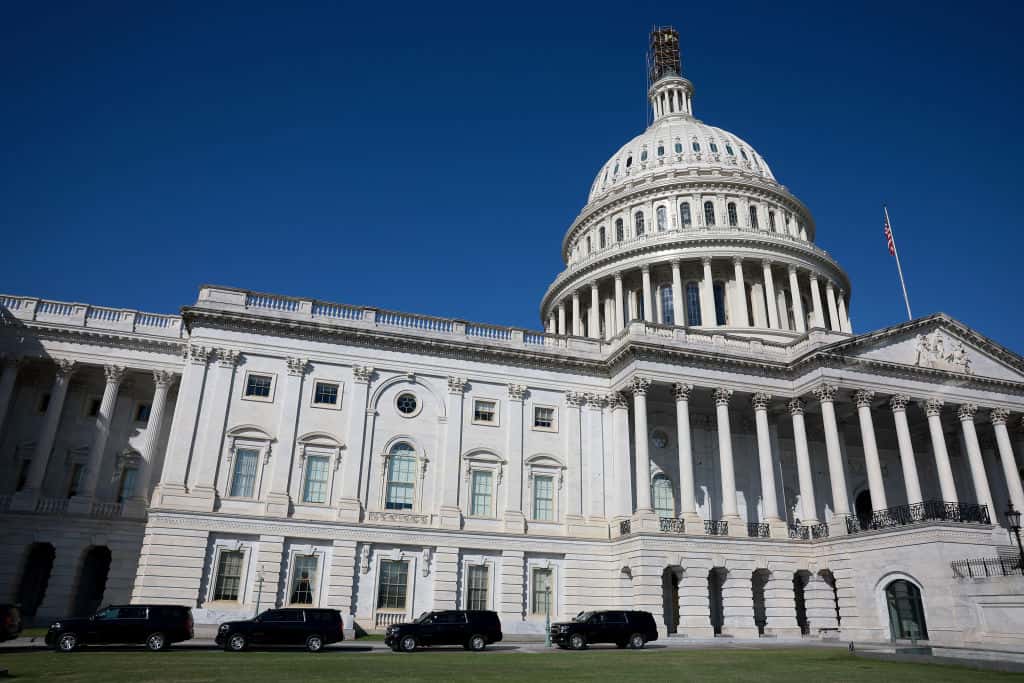Beyond the Buzzwords: Digital Transformation in Manufacturing

Technology is constantly changing. But how will this era of digital transformation change the manufacturing industry?
The NAM’s Leading Edge program partnered with Siemens to present “Beyond the Buzzwords: A Digital Thread Journey,” a four-part webinar series dedicated to understanding how cutting-edge ideas affect manufacturers. In the first episode, we put the digital transformation journey in context by introducing the “digital thread.” In the next three, we dove deeper into cloud acceleration, artificial intelligence and radical flexibility.
Cloud acceleration: A business’s digital needs are covered by a combination of software, hardware and physical infrastructure. If you turn to an offsite partner to provide any of those elements, then you are probably already using cloud acceleration to support your business.
- We spoke with Surf Loch Director of Project and Process Development Bryan Behr, Siemens Senior Vice President of Cloud Application Services Raymond Kok and Surf Loch Systems Engineer Miles Miller to learn more.
What it is: Cloud acceleration refers to a wide range of on-demand computing services hosted outside of your organization.
- Kok explained that cloud acceleration “is really a layer cake with three layers to it.” At the highest level is “infrastructure as a service,” like data centers. In the middle is “platform as a service,” which might provide you with the building blocks to create your own applications. And at the final layer is “software as a service,” which is what you would typically get from a commercial software vendor.
How it helps: Cloud acceleration is easier, more cost effective and more flexible than managing all of your computing needs internally.
- “The cool thing about the cloud is how containerized everything is,” said Miller. “Data is readily available in a very organized fashion. … If there’s a problem or something needs to be solved, we can put that data in the right hands.”
- Behr also pointed out the benefits for digital security. “It’s either rely on one thing to maintain our security on premise or rely on a very sophisticated cloud team as part of a set of resources. … [I]t became pretty obvious that that appears to be a safer place for us than potentially on premise.”
Learn more: To learn more about cloud acceleration, check out the full webinar here.
AI/machine learning: We know that AI and machine learning are affecting every industry. But how should manufacturers use this new technology?
We brought together Siemens Advanta North America CEO Rani Russell Shea and Schaeffler Special Machinery Head of Electrical & Software Engineering Stefan Gahabka to learn about how to approach AI.
How it works: “The basic idea with AI is that you use data to train models,” said Shea. “Those models can run analytics and then essentially make decisions while learning things, like pattern detection. And then when you’re talking specifically about industrial AI, you’re talking about using AI for machine learning solutions, to solve business problems, things like factory optimization.”
Augmenting humanity: According to Shea and Gahabka, AI is intended to elevate the human factor in manufacturing, not replace it.
- “Everybody really wants to be able to do their job better, faster, more accurately, more safely, more sustainably,” said Shea. “AI … is going to help us do that, and by doing that, it’s literally elevating the role of people so we’re free to then use our creativity, our experience and our knowledge to really address the complex stuff.”
Doing more: AI can be used to measure, model and optimize everything from energy usage to supply chains—even helping manufacturers find the right partners to match their sustainability objectives.
- “We talk about the hard things like quality and cost, but can also think about the next step,” said Gahabka. “We can search for suppliers that have sustainable locations and goals.”
Learn more: To learn more about AI and machine learning, check out the full webinar here.
Radical flexibility: Many think of efficient manufacturing in terms of highly standardized automatable processes. Today, though, new technology is creating new possibilities for manufacturers.
We convened an expert panel with Vice-President of Digital Enterprise at Siemens Alastair Orchard, Global Engineering Director and Automation & Robotics Lead at Unilever Cesare Gibilaro, and Process Orchestration & Manufacturing Hub, Manager for Business Operations at Unilever Louise Gigg to introduce us to radical flexibility and the future of manufacturing.
What it is: Technological advancements are making it possible for manufacturers to make only what is needed when it is needed, rather than having hard-coded machines that limit what your business can do for the sake of efficiency.
- For much of the past century, according to Orchard, manufacturers had been focused on “removing degrees of freedom from manufacturing, making it more rigid, so that automation could be applied to extremely repeatable processes … radical flexibility really challenges that assumption to its core. And we asked: what if nothing was hard coded?”
- “The radical way of looking at it,” said Gigg, “is reconfiguring the asset that you have on automation [and giving it] a new task or a new capability that it didn’t have yesterday.”
How to use it: Radical flexibility is all about using your assets more effectively and more efficiently to deliver more options for your customers.
- Gibilaro highlighted the ability to change directions with incredible speed. “With radical flexibility, we have the opportunity to reconfigure the line. … It is not a matter of hours, but a matter of minutes.”
Why it matters: Because radical flexibility allows processes to shift quickly, there’s less wasted time and inventory.
- “It’s this ability to make things where you need them in small quantities,” said Orchard. “You’re risking much less, and you’re not forced to make these giant bets.”
Learn more: To learn more about radical flexibility, check out the full webinar here.
Beyond the Buzzwords: Manufacturers Tackle Digital Threads

A manufacturing business is filled with internal processes, workflows and standards, and the average factory generates thousands of data points per day. But how does a manufacturer capture that data? How do they preserve institutional knowledge? What if they could automate workflow, create seamless project handoffs and track development around every stage of a project’s life?
The NAM’s Leading Edge program, in partnership with Siemens, asked a panel of experts these questions in “Beyond the Buzzwords: The Digital Thread Journey,” the first in a four-part webinar series focused on understanding the “digital thread” in the workplace. In the first installment of the series, Siemens Vice President of Industry Strategy Dale Tutt and Anduril Industries Chief of Engineering Tom McCarthy introduced us to the idea of the digital thread—what it is, why it matters and how manufacturers can harness its power to succeed.
What it is: The digital thread is a concept rather than a specific technology. According to Tutt, it is about capturing and connecting every piece of a project’s life cycle digitally, and using that connectivity to provide a seamless transition of information from one functional area to another.
- “We often refer to a digital thread as singular, like it’s a thing,” said McCarthy. “But really, in my mind, it’s a lot of threads. … it ends up being more like a rope than a thread.”
Why it matters: A strong digital thread can automate a manufacturer’s workflow, capture data more effectively, preserve institutional knowledge, trace development processes and even capture the context that informs how decisions are made.
- Radically new technology means that organizations can accomplish these tasks more successfully than ever before—and that those who ignore that opportunity could be left behind.
- “The biggest risk is to do nothing and assume this fad will go away,” said McCarthy.
The challenges: One of the biggest challenges in building a strong digital thread in your own workspace is integration and data management.
- Manufacturing systems need to manage lots of data coming to it in different formats. But according to Tutt, that data needs to be organized in a comprehensible way. “It’s about producing the right data at the right time in the right … format,” said Tutt.
- According to McCarthy, a digital thread isn’t just a database. It is the key that deciphers that data and makes it accessible and intelligible for the user. “We need a Rosetta Stone,” said McCarthy, “to be able to understand how that data maps onto other tools.”
Implementation and technology: New technology and strategic concepts have enhanced our capacity to build strong digital threads—and with that new ability has come a new and urgent need to make use of the concept to strengthen the manufacturing industry.
- To get started on your own digital thread journey, Tutt and McCarthy agreed that manufacturers should dig into the existing workflows in their organization and introduce one tool at a time, rather than trying to engineer a master solution all at once.
- “You can work the digital infrastructure you need for that workflow in pieces, so you can build them up over time,” said McCarthy. “You got to keep your eye on the end game, but if you try to build it all at once, good luck.”
Learn more: To learn more about digital threads, check out the full webinar here.
Coming up: In the next three webinars in this series, Beyond the Buzzwords explores a few of those tools and concepts that drive the digital thread in the modern day: artificial intelligence, cloud advancements and radical flexibility.
PA Manufacturer: Preserve “Keystone” Tax Provisions

The U.S. tax code is a keystone of our nation’s economic competitiveness, Erie Molded Packaging President Tom Tredway told the House Ways and Means Tax Subcommittee at a field hearing on Monday. But pro-growth tax provisions have begun expiring, with more tax increases on the way next year—so that keystone has started to crack, “weakening the entire structure” of the country.
What’s going on: Tredway gave testimony at a hearing in his hometown of Erie, Pennsylvania, the namesake of his 42-year-old, family-owned custom injection molded parts and packaging solutions company.
- Tredway told Ways and Means Committee Chairman Jason Smith (R-MO), Tax Subcommittee Chairman Mike Kelly (R-PA) and others of the negative effects his business has seen since the expiration of three provisions from the 2017 Tax Cuts and Jobs Act: immediate expensing for domestic research and development, enhanced interest deductibility and full expensing.
- And Tredway put the committee on alert: additional TCJA expirations are scheduled for the end of 2025, and small manufacturers “will be disproportionately harmed” by congressional inaction to preserve these vital policies.
A winning formula: The expired provisions—as well as other, soon-to-expire measures—were like rocket fuel for manufacturers and the rest of the economy.
- “In the years following TCJA, Erie Molded was able to invest nearly $7 million in new capital equipment purchases thanks to full expensing,” Tredway said. “Along with this much-needed equipment, we were able to create new positions across our team, and we were able to deliver higher quality products faster to our customers.”
But now… Tredway’s company has had to delay important equipment purchases, and last year, its taxable income “was almost six figures higher” than Tredway had anticipated.
- What’s more, when the 20% pass-through deduction—currently taken by companies in which profits pass through to the owner and are thus taxed at the individual rate—expires at the end of 2025, Erie Molded Packaging will see another tax hike it can ill afford, “severely hampering [the company’s] growth trajectory.”
What should be done: Congress must pass the Tax Relief for American Families and Workers Act as soon as possible—and act to prevent tax hikes in 2025, Tredway told those at the hearing.
- “I urge every member of this committee to preserve these and the other pro-growth provisions, which allow manufacturers to function as the backbone of our economy and compete on a global scale.”
NAM Files Suit to Block OSHA “Walkaround” Rule

The NAM and allied groups are challenging the U.S. Occupational Safety and Health Administration’s recently finalized “walkaround” rule.
What’s going on: On Tuesday, the NAM, joined by like-minded business organizations, filed a lawsuit in the Western District of Texas to block OSHA’s final rule revising the Worker Walkaround Representative Designation Process. That rule was finalized in April and is set to go into effect May 31.
- The new rule would allow nonemployees—including union representatives, plaintiffs’ attorneys, community organizers and even competitors—to accompany OSHA inspectors on workplace safety inspections.
Why it’s a problem: Not only does the final rule fail to advance the agency’s mission of ensuring workplace safety, but it is beyond the scope of OSHA’s authority. What’s more, it violates businesses’ rights, the NAM said.
- The new regulation “infringes on manufacturers’ right to exclude others from their property, threatens new liabilities and risks compromising manufacturers’ intellectual property. The NAM Legal Center is filing suit to prevent this harm,” NAM Chief Legal Officer Linda Kelly said.
NAM to Senate: Administration March-in Proposal Undermines IP, Innovation

The Biden administration’s push to invoke “march-in” rights is unlawful and would have “disastrous consequences” for the United States if enacted, the NAM told the Senate Tuesday.
What’s going on: Ahead of a Senate Judiciary Committee hearing on intellectual property in the biopharmaceutical sector, the NAM warned of the potentially dire consequences of the proposed march-in framework issued by the National Institute of Standards and Technology.
- The NIST proposal would allow the federal government to “march in” and seize manufacturers’ patent rights if an innovation was developed in any part with federal dollars.
- In the biopharmaceutical sector and other innovative industries, federal funding plays an important role in supporting early-stage research—but further R&D, product development and commercialization require hundreds of millions to billions of dollars in additional capital from investors and established companies.
- Robust IP protections ensure that manufacturers can bring innovative products to consumers.
Why it’s a problem: March-in would violate manufacturers’ IP rights and prevent investment into lifesaving and life-changing technologies, according to NAM Vice President of Domestic Policy Charles Crain.
- “Allowing march-in based on the price of a product or technology, as the NIST guidance proposes … would undermine manufacturers’ IP rights and have sweeping ramifications for innovation in the United States and America’s world-leading innovation economy,” Crain told the committee.
- Committee member Sen. Chris Coons (D-DE) agreed during the hearing that the proposal is fundamentally flawed. “Any company [that] invents [anything] or any researcher who invents anything is now open to the federal government saying, ‘I want that, and I don’t agree with the price you’re setting for it,’” he said.
What should happen: Congress must stop NIST’s overreach, Crain said.
- “Policies that threaten IP protections, like NIST’s proposed march-in guidance, will cede one of our greatest advantages to our competitors. Manufacturers [look forward] to work[ing] with the committee to ensure the U.S. maintains the strongest IP protections in the world in order to spur the discovery and commercialization of inventions that improve health and quality of life for all people.”
Manufacturers Challenge OSHA’s Unlawful Walkaround Rule
The NAM Legal Center Joins Industry Groups Seeking to Block Rule
Washington, D.C. – Today, the National Association of Manufacturers, joined by other business groups, filed suit in the Western District of Texas to challenge the Occupational Safety and Health Administration’s final rule amending the Worker Walkaround Representative Designation Process (Walkaround Rule).
The Walkaround Rule will allow an unlimited number of third parties, such as union representatives, plaintiffs’ attorneys and community organizers, to accompany OSHA inspectors on safety inspections.
“OSHA’s rule does nothing to advance its mission of improving workplace safety,” said NAM Chief Legal Officer Linda Kelly. “This rule is well beyond the scope of OSHA’s authority, and it infringes on manufacturers’ right to exclude others from their property, threatens new liabilities and risks compromising manufacturers’ intellectual property. The NAM Legal Center is filing suit to prevent this harm.”
Background:
- For more than 50 years, OSHA’s walkaround regulation authorized only an employee of an employer to serve as another employee’s representative during an OSHA inspection.
- In 2013, then-Deputy Assistant Labor Secretary Richard Fairfax issued a letter—commonly referred to as the Fairfax Memo or Sallman Letter—to a member of the Service Workers International Union, which stated that a nonemployee affiliated with a union or community organization could serve as a representative of employees during an OSHA inspection at a worksite without a collective bargaining agreement.
- In 2017, a trade group challenged the Fairfax Memo as unlawfully issued outside the notice-and-comment process and inconsistent with OSHA’s regulation that authorized only an employee of an employer to serve as another employee’s representative during an OSHA inspection.
- A federal court in Texas agreed with the trade group, and the Trump administration later rescinded the memo.
- In August 2023, OSHA released the proposed Walkaround Rule, and the NAM submitted comments urging OSHA to withdraw it.
-NAM-
The National Association of Manufacturers is the largest manufacturing association in the United States, representing small and large manufacturers in every industrial sector and in all 50 states. Manufacturing employs nearly 13 million men and women, contributes $2.89 trillion to the U.S. economy annually and accounts for 53% of private-sector research and development. The NAM is the powerful voice of the manufacturing community and the leading advocate for a policy agenda that helps manufacturers compete in the global economy and create jobs across the United States. For more information about the NAM or to follow us on Twitter and Facebook, please visit www.nam.org.
NAM, State Partners Call for Immediate Senate Action on Tax Bill

The Senate should immediately pass the Tax Relief for American Families and Workers Act, the NAM and its state partners told congressional leaders this week.
What’s going on: The NAM—along with 47 state manufacturing associations—on Monday continued its longtime, ongoing advocacy for the tax bill, which would restore three sector-crucial tax provisions: immediate expensing for domestic research and development expenses, enhanced interest deductibility on business loans and 100% accelerated depreciation for capital investments.
- “This critical legislation will support the ability of manufacturers in America to create jobs, invest in our businesses, give back to our communities and effectively compete in the global economy,” the groups said.
Why it’s important: If Congress fails to restore these key tax provisions, America’s competitiveness on the world stage will be under threat, they continued.
- “Without tax policies that encourage R&D and capital investment, countries with more favorable tax systems are capturing job-creating manufacturing investments.”
- China, for example, provides a 200% “super deduction” for companies’ R&D expenses, which is 10 times more than the U.S. gives. In 2022, the first full year following the expiration of immediate R&D expensing in the U.S., China’s R&D growth was three times that of the U.S.
What’s next: The Senate must not delay, the associations said. Congress must pass the Tax Relief for American Families and Workers Act—now.
The last word: “The breadth and depth of support for these critical, pro-growth tax provisions throughout the manufacturing industry shows the importance of immediate congressional action,” said NAM Vice President of Domestic Policy Charles Crain. “With additional damaging tax increases scheduled for next year, manufacturers cannot afford further delays.”
NAM Gets New International Policy Lead

Former Assistant U.S. Trade Representative for World Trade Organization and Multilateral Affairs Andrea Durkin has joined the NAM as vice president of international policy, the NAM announced Monday.
An experienced leader: “Andrea brings a wealth of expertise to the job, with more than three decades of service in both the public and private sectors,” NAM President and CEO Jay Timmons said. “As a leader in international trade negotiations, her deep understanding of international policy will enhance the NAM’s strategic objectives significantly as we continue to build off of successful engagements with our counterparts across Europe and the North American continent.”
- Durkin is a foremost U.S. expert on international policy, having worked in both Republican and Democratic presidential administrations. In her most recent role, at the USTR in the Executive Office of the President, she negotiated policy regarding issues before the WTO. She also led the operation of committees on technical barriers to trade, industrial subsidies, trade facilitation and more.
- Her negotiations credentials include free trade agreements in the Western Hemisphere and the trade-related portions of United Nations’ multilateral environment and public health agreements.
A teacher and an entrepreneur: An adjunct professor for 17 years, Durkin taught international trade and investment policy at Georgetown University’s Master of Science in Foreign Service program.
- She is also the founder of Sparkplug, LLC, a consulting firm that specialized in advising corporate affairs teams and think tank leaders on organizational strategy.
USTR’s WTO Lead Andrea Durkin to Lead NAM International Policy Team
NAM Advocates Global Trade Strategy That Will Open New Markets with Our Allies and Create Vast Opportunities for Manufacturers in the U.S.
Washington, D.C. – The National Association of Manufacturers announced that former Assistant U.S. Trade Representative for WTO and Multilateral Affairs Andrea Durkin is joining the NAM as the new vice president of international policy.
“Andrea brings a wealth of expertise to the job, with more than three decades of service in both the public and private sectors. As a leader in international trade negotiations, her deep understanding of international policy will enhance the NAM’s strategic objectives significantly as we continue to build off of successful engagements with our counterparts across Europe and the North American continent,” said NAM President and CEO Jay Timmons.
“As manufacturers in America look for new ways to reach global markets and the 95% of customers that live outside the borders of the United States, Andrea is set to lead an ambitious expansion of the NAM’s international policy operation. She will work to uphold our commitment to shaping a global trade strategy that opens new markets with our allies and trading partners around the world, which, in turn, will create vast opportunities for manufacturers in the U.S. to create well-paying jobs, innovate and achieve new milestones in improving the quality of life for everyone.”
Durkin is one of the nation’s foremost experts on international policy, drawing from decades of experience serving in Democratic and Republican administrations. As a senior executive in the Office of the President, she led trade negotiations and U.S. policy at the WTO and was responsible for committees on industrial subsidies, technical barriers to trade, government procurement, trade facilitation, customs and others. She was also the U.S. senior official for the Organization for Economic Co-operation and Development Trade Committee, G7 and G20 trade tracks.
In years prior, Durkin served in the U.S. Department of Commerce’s International Trade Administration, where she led a variety of negotiations, including free trade agreements in the Western Hemisphere, sectoral initiatives in the Asia-Pacific Economic Cooperation and trade-related aspects of United Nations’ multilateral environment and public health agreements.
-NAM-
The National Association of Manufacturers is the largest manufacturing association in the United States, representing small and large manufacturers in every industrial sector and in all 50 states. Manufacturing employs nearly 13 million men and women, contributes $2.89 trillion to the U.S. economy annually and accounts for 53% of private-sector research and development. The NAM is the powerful voice of the manufacturing community and the leading advocate for a policy agenda that helps manufacturers compete in the global economy and create jobs across the United States. For more information about the NAM or to follow us on Twitter and Facebook, please visit www.nam.org.
NAM Urges Passage of New MTB Bill

The House should move quickly to pass the Miscellaneous Tariff Bill Reform Act, legislation on which the NAM has led advocacy efforts.
What’s going on: On Tuesday, House Ways and Means Trade Subcommittee Chairman Adrian Smith (R-NE) introduced the Miscellaneous Tariff Bill Reform Act, which seeks to renew the MTB—a manufacturing-critical law that temporarily removes or reduces tariffs on products not available in the U.S.—as soon as possible.
- The NAM, which has long urged Congress to take up the issue, lauded the legislation and called for its swift passage.
- “Historically, the MTB has always had bipartisan support, and we thank House Ways and Means Trade Subcommittee Chairman Adrian Smith for his leadership and efforts to introduce MTB legislation,” said NAM Managing Vice President of Policy Chris Netram in a statement cited by Chairman Smith’s office. “We urge the House to act quickly so that we can get one step closer to getting this critical legislation to President Biden’s desk.”
- The last MTB expired in December 2020.
Why it’s important: In the nearly three years that they have been operating without an MTB, manufacturers and other businesses in the U.S. have paid more than $1.3 million a day to get inputs they cannot find in the U.S., according to an NAM analysis.
- Passing the MTB through 2026, on the other hand, and reauthorizing passage of future MTB cycles will boost U.S. competitiveness.
- Tariff relief under the previous MTB increased U.S. gross domestic product by up to $3.3 billion every year, according to the U.S. International Trade Commission.
